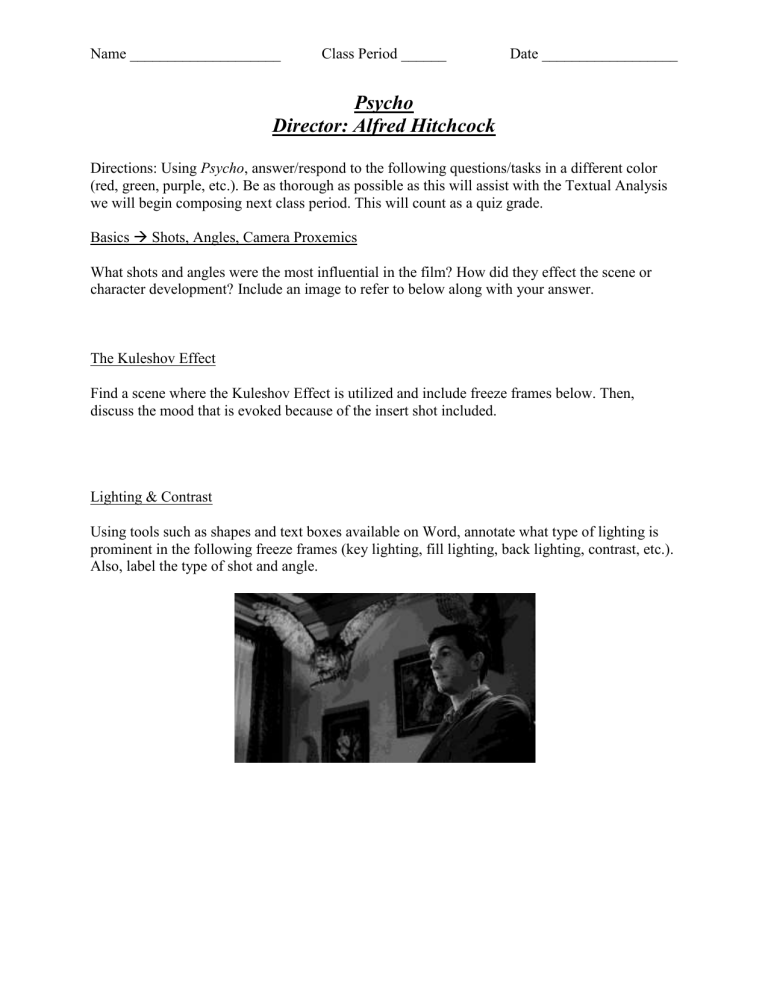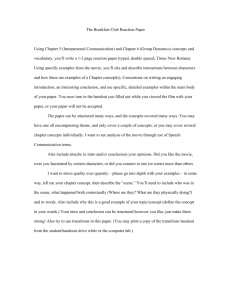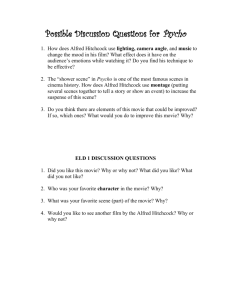
Name ____________________ Class Period ______ Date __________________ Psycho Director: Alfred Hitchcock Directions: Using Psycho, answer/respond to the following questions/tasks in a different color (red, green, purple, etc.). Be as thorough as possible as this will assist with the Textual Analysis we will begin composing next class period. This will count as a quiz grade. Basics Shots, Angles, Camera Proxemics What shots and angles were the most influential in the film? How did they effect the scene or character development? Include an image to refer to below along with your answer. The Kuleshov Effect Find a scene where the Kuleshov Effect is utilized and include freeze frames below. Then, discuss the mood that is evoked because of the insert shot included. Lighting & Contrast Psycho (1960) Viewing Using tools such as shapes and text boxes available on Word, annotate what type ofLog lighting is Giveframes a one sentence synopsis of what is occurring in this etc.). scene. Take note of prominent in the following freeze (key lighting, fill lighting, back lighting, contrast, techniques used in this particular freeze frame. Also, label the type of shot and angle. Psycho (1960) Viewing Log tence synopsis of what is occurring in this scene. Take note of major cinematic techniques used in this particular freeze frame. Sound/Score Using the scene provided in the link below, analyze the score composed by Bernard Hermann. https://www.youtube.com/watch?v=8VP5jEAP3K4 Diegetic Sound vs. Non-Diegetic Sound 1. Describe whether the score contains diegetic sound or non-diegetic sound. Or both. The score in these scene is non-diegetic as you can hear the music that is intensifying every time the killer gets closer to her, so she does not get a chance to see that something is coming, and another thing that it could be is that the killer was very silent so she did not have a chance to react to what was happening behind her. Pace 2. Is the tempo quick paced, moderately paced, slow paced? Is this momentum kept up throughout the score? Does it slow down? Where and why? Its goes faster every time something is happening, for instance when the detective is going up the stair the score in the movie starts to go faster meaning that somethings is going to happen and when the killer comes out the score goes super-fast and super loud until he dies, the same with Marion. Voice 3. Is it high pitched or low pitched? What is the tone of the voice/instrument? Moderate, standard Measure 4. Is there a consistent rhythm kept? Or is free time incorporated in some places? There is a constant rhythm but it just goes faster as the movie goes on, the only place where the rhythm goes crazy is when the killer appears and you can say that the volume and rhythm of the song could be the reaction of the spectator, for instance when it going faster because there is something behind someone can represent the panic in the spectators in trying to make the character look back. Mood 5. What mood is evoked? Does it change throughout the score? Thanks to all the situations that are happening during the movie and the songs and that it starts with Marion running away and the main characters show 40 min into the movie makes the mood in the movie as if you can’t trust anything that is going on in the movie and every time the movie goes further into the climax you can appreciate that nothing is what it looks like. Analysis 6. How is this piece of music fitting for the genre it appears in? Is the mood fitting with the scene? Or are there opposing moods present visually? Discuss the effect. Connect to character development, conflict (internal/external), abstract concept, etc. All of the music that appears during the movie is to give more suspense in tense situations, when Marion is in the car or when she is getting killed. For Marion, the music affects the internal and external conflict a lot during the movie because every time she is hearing what people could say on her mind it demonstrates how she feels guilty on what happened. Visual Symbolism Visual symbols are representations of direct reality which come in the form of signs and symbols. A physical representation (either object or mark) that stands in for another object or idea/theme. What visual symbol is apparent in the film? What is it symbolic of? Consider Hitchcock’s era and when this film was released (1960). What historical, institutional, technological, social, or economic explanations can you connect to this symbol? A big symbol during the movie is that the birds in the office of Norman represent that Marion wasn’t actually the first arriving to the motel, and this shows how Norman is not what he first looks and acts in the movie there is more to it. Ideas/Themes to Consider Critic Slavoj Zizek suggests that the relationship between Marion and Norman can be seen as "true love." Is he right? Wrong? For me I think that he is wrong do to the fact of how Norman threats Marion, for instance he spies on her and even kills her, there is a difference between being polite and having true love. Polite reefers in the way he is to other people not in the creepy way of his reactions to things. If it was true love the personality of Norman would have do all in his power to stop his mother on killing Marion. The main character in the film is really Norman Bates. How would the film change if you followed Norman's perspective all through? You would probably change the perspective of what it was going on inside his mind and what happen in the past and the regret that he got from that experience 10 years before. Another thing is that he would not have an excuse anyway of killing all the people that he killed during the movie


